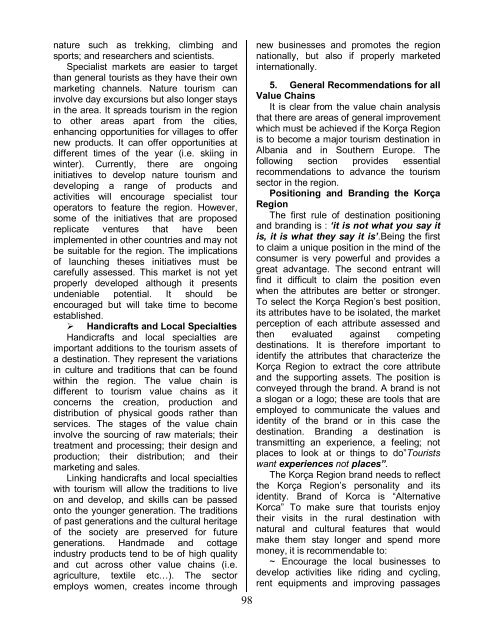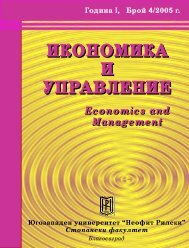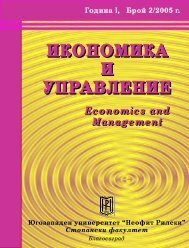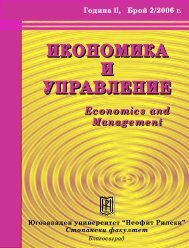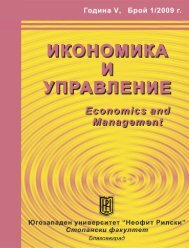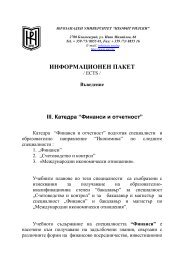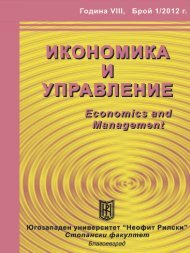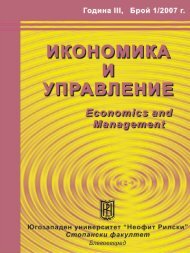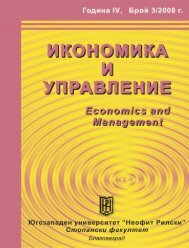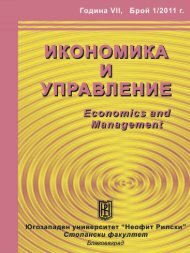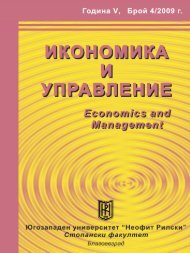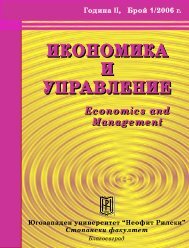ÐÑой 4/2010 - СÑопанÑки ÑакÑлÑÐµÑ - Югозападен ÑнивеÑÑиÑеÑ
ÐÑой 4/2010 - СÑопанÑки ÑакÑлÑÐµÑ - Югозападен ÑнивеÑÑиÑеÑ
ÐÑой 4/2010 - СÑопанÑки ÑакÑлÑÐµÑ - Югозападен ÑнивеÑÑиÑеÑ
You also want an ePaper? Increase the reach of your titles
YUMPU automatically turns print PDFs into web optimized ePapers that Google loves.
nature such as trekking, climbing and<br />
sports; and researchers and scientists.<br />
Specialist markets are easier to target<br />
than general tourists as they have their own<br />
marketing channels. Nature tourism can<br />
involve day excursions but also longer stays<br />
in the area. It spreads tourism in the region<br />
to other areas apart from the cities,<br />
enhancing opportunities for villages to offer<br />
new products. It can offer opportunities at<br />
different times of the year (i.e. skiing in<br />
winter). Currently, there are ongoing<br />
initiatives to develop nature tourism and<br />
developing a range of products and<br />
activities will encourage specialist tour<br />
operators to feature the region. However,<br />
some of the initiatives that are proposed<br />
replicate ventures that have been<br />
implemented in other countries and may not<br />
be suitable for the region. The implications<br />
of launching theses initiatives must be<br />
carefully assessed. This market is not yet<br />
properly developed although it presents<br />
undeniable potential. It should be<br />
encouraged but will take time to become<br />
established.<br />
‣ Handicrafts and Local Specialties<br />
Handicrafts and local specialties are<br />
important additions to the tourism assets of<br />
a destination. They represent the variations<br />
in culture and traditions that can be found<br />
within the region. The value chain is<br />
different to tourism value chains as it<br />
concerns the creation, production and<br />
distribution of physical goods rather than<br />
services. The stages of the value chain<br />
involve the sourcing of raw materials; their<br />
treatment and processing; their design and<br />
production; their distribution; and their<br />
marketing and sales.<br />
Linking handicrafts and local specialties<br />
with tourism will allow the traditions to live<br />
on and develop, and skills can be passed<br />
onto the younger generation. The traditions<br />
of past generations and the cultural heritage<br />
of the society are preserved for future<br />
generations. Handmade and cottage<br />
industry products tend to be of high quality<br />
and cut across other value chains (i.e.<br />
agriculture, textile etc…). The sector<br />
employs women, creates income through<br />
98<br />
new businesses and promotes the region<br />
nationally, but also if properly marketed<br />
internationally.<br />
5. General Recommendations for all<br />
Value Chains<br />
It is clear from the value chain analysis<br />
that there are areas of general improvement<br />
which must be achieved if the Korça Region<br />
is to become a major tourism destination in<br />
Albania and in Southern Europe. The<br />
following section provides essential<br />
recommendations to advance the tourism<br />
sector in the region.<br />
Positioning and Branding the Korça<br />
Region<br />
The first rule of destination positioning<br />
and branding is : ‘it is not what you say it<br />
is, it is what they say it is’.Being the first<br />
to claim a unique position in the mind of the<br />
consumer is very powerful and provides a<br />
great advantage. The second entrant will<br />
find it difficult to claim the position even<br />
when the attributes are better or stronger.<br />
To select the Korça Region’s best position,<br />
its attributes have to be isolated, the market<br />
perception of each attribute assessed and<br />
then evaluated against competing<br />
destinations. It is therefore important to<br />
identify the attributes that characterize the<br />
Korça Region to extract the core attribute<br />
and the supporting assets. The position is<br />
conveyed through the brand. A brand is not<br />
a slogan or a logo; these are tools that are<br />
employed to communicate the values and<br />
identity of the brand or in this case the<br />
destination. Branding a destination is<br />
transmitting an experience, a feeling; not<br />
places to look at or things to do”Tourists<br />
want experiences not places”.<br />
The Korça Region brand needs to reflect<br />
the Korça Region’s personality and its<br />
identity. Brand of Korca is “Alternative<br />
Korca” To make sure that tourists enjoy<br />
their visits in the rural destination with<br />
natural and cultural features that would<br />
make them stay longer and spend more<br />
money, it is recommendable to:<br />
~ Encourage the local businesses to<br />
develop activities like riding and cycling,<br />
rent equipments and improving passages


